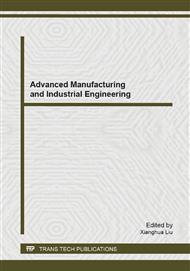[1]
A. M. Thompson Science, 256(1992): 1157-1165.
Google Scholar
[3]
H. Ohshima, M. Tatemichi, T. Sawa. Arch Biochem Biophys, 417(2003): 3-11.
Google Scholar
[4]
M. P. Mattson. Nature, 430(2004): 631-639.
Google Scholar
[5]
J. P. Fruehauf, F. L. Meyskens. Cancer Res., 13(2007): 789-794.
Google Scholar
[6]
M. Xu, B. R. Bunes, L. Zang. ACS Appl. Mater. Interfaces, 3(2011): 642-647.
Google Scholar
[7]
H. W. Lin, K. S. Suslick. J. Am. Chem. Soc., 132(2010): 15519-15521.
Google Scholar
[8]
N. V. Klassen, D. Marchington, H. C. E. McGowan. Anal. Chem., 66(1994): 2921-2925.
Google Scholar
[9]
P. X. Yuan, Y. Zhuo, Y. Q. Chai, et al. Electroanalysis, 20(2008): 1839-1844.
Google Scholar
[10]
W. Z. Jia, M. Guo, Z. Zheng, et al. Electroanalysis, 20(2008): 2153-2157.
Google Scholar
[11]
S. Oszwałdowski, R. Lipka, M. Jarosz. Anal. Chim. Acta, 421(2000): 35-43.
Google Scholar
[12]
G. Shan, S. Zheng, S. Chen, et al. Colloids Surf. B, 102(2013): 327-330.
Google Scholar
[13]
O. Woleis, A. D¨urkop, M. Wu, et al. Angew. Chem. Int. Ed., 41(2002): 4495-4498.
Google Scholar
[14]
X. H. Shu, Y. Chen, H. Y. Yuan, et al. Anal. Chem., 79(2007): 3695-3702.
Google Scholar
[15]
A. R. G. C. Lippert, V. D. Bittner, C. Chang. J. Acc. Chem. Res., 44(2011): 793-804.
Google Scholar
[16]
Y. Hitomi, T. Takeyasu, T. Funabiki, et al. Anal. Chem., 83(2011): 9213-9216.
Google Scholar
[17]
X. L. Sun, S. Y. Xu, S. E. Flower. Chem. Commun., 49(2013): 8311-8313.
Google Scholar
[18]
F. B. Yu, P. Li, P. Song, et al. Chem. Commun., 48(2012): 4980-4982.
Google Scholar
[19]
B. C. Dickinson, C. J. Chang. J. Am. Chem. Soc., 130(2008): 9638-9639.
Google Scholar
[20]
B. D'Autréaux, M. B. Toledano. Nat. Rev. Mol. Cell Biol., 8(2007): 813-824.
Google Scholar
[21]
J. Xu, Q. Li, Y. Yue, et al. Biosensors and Bioelectronics, 56(2014): 58-63.
Google Scholar
[22]
Y. Y. Qian, L. Xue, D. X. Hu, et al. Dyes and Pigments, 95(2012): 373-376.
Google Scholar
[23]
F. Hu, Y. Y. Huang, G. X. Zhang, et al. Tetrahedron Letters 55: (2014) 1471-1474.
Google Scholar
[24]
Y. M. Shen, J. Zhao, L. Li, et al. Guan Zhou Chemical Industry, 42(2014): 47-48 (In Chinese).
Google Scholar


